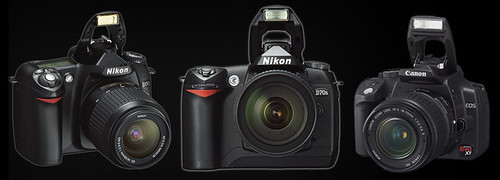Subtle differences between digital SLRs for astrophotography
Permalinks to this entry: individual page or in monthly context. For more material from my journal, visit my home page or the archive.
Among those looking for a digital SLR (which I'm not, yet), Canon and Nikon are by far the top contenders. Other manufacturers, from Pentax and Olympus to Kodak and (soon) Sony are also in the race, but they're far, far back in most people's minds. My dad just bought himself a $1300 Cdn Canon Digital Rebel XT 350D DSLR dual-lens kit over the weekend, which was a strange choice, but he had good reasons.
Here's why it was a strange choice. He knows his cameras—he used to make a living as a wedding photographer more than 40 years ago—but the Canon is the first new SLR of any kind he's bought in more than 30 years, so his old manual-focus Pentax lenses weren't part of his decision. Yet I own three good Nikon-mount 35 mm autofocus lenses that work great on Nikon DSLRs: a fixed 50 mm f1.8 that takes nice photos in low light, plus two quality zoom lenses. He could have used those if he'd bought a Nikon D50, which was the second main camera on his list, and saved himself about $500.
But he is an amateur astronomer (former national treasurer of the Royal Astronomical Society of Canada, in fact) and likes to take astrophotographs, which have unusual demands on a camera, whether film or digital. Yes, there are specialized telescope CCDs and expensive astronomy-optimized DSLRs like Canon's D20a, but my dad wanted a relatively inexpensive camera that would work both with his telescopes and for general photography.
The differences he discovered between the Canons and the Nikons were interesting, subtle, unnoticeable by most non-astrophotography buffs, and enough to compel him to spend the extra money, with two key items being most critical:
- The Canon offers mirror lock-up, which lets you flip up the internal viewing mirror in advance of taking a photo, and thus prevent the inevitable vibration from the flipping mechanism that can affect the slow exposures done through telescopes (although not the really slow minutes- or hours-long ones used for deep dark-sky photography). The Nikon doesn't have lock-up at all.
- The Nikon's NEF "raw" format (also apparent on the higher-end D70s and other Nikon DSLRs) isn't really lossless, raw data from the camera sensor, but involves slight anti-noise processing in the camera, which is an advantage for terrestrial photography, but can kill the fine detail required of dark-sky pictures—and which you can't turn off. Canon lets you get straight data from the sensor and do your own processing.
Of course, as in other geeky religious wars, the debate continues in many forums, but Canon's advantage for astrophoography seems clear. Even aside from these particular models, Nikon doesn't even make a specialized astro-SLR like the D20a, preferring to specialize in medical and other less sky-searching areas.
So my father is now a Canon guy, while I'm a Nikon guy. And I run Macs and he runs Windows. And we never argue about either of them.








